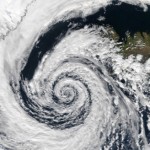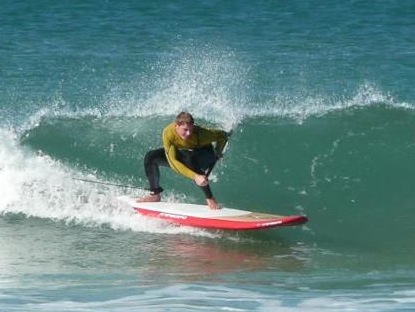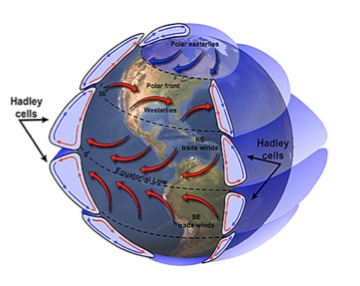
Weather and waves play a massive part in any watersport, SUP included. Learning about weather and knowing what to look out for on a forecast can either make or break your session. And also help you make a call on whether a long drive to the beach is worth it. Over the course of these features Scott Warren will cover the basics behind wave theory from a surfer’s point of view.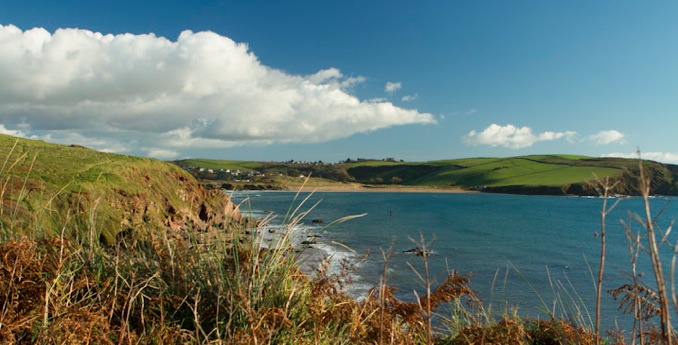
- Part.1 – Weather Systems. The fundamentals behind the growth of waves. By exploring the large scale weather patterns present on the Earth, and building a picture on the formation of Low Pressure Systems and why these are important to understand.
- Part.2 – The Growth and Propagation of Waves. How waves begin to grow in size as they are produced by the swirling winds associated with Low Pressure Systems, and how they begin their journeys to our coastlines. Looking at why ‘Sets’ and ‘Groups’ of waves occur and how we can begin to understand why waves arrive perfectly lined up one day and in a sometimes seemingly random fashion the next. By understanding how and why waves are formed and move as they do, we can then look at what happens when the waves reach our coastlines.
- Part.3 – Local Bathymetry (the effects of the Coastline and Sea Floor upon waves) Why waves are different in one location to the next, and how the topography (sea floor profile) of any given ‘Spot’ alters the wave type we are able to surf. Also how the waves themselves can shape the environment around the coastline through erosion and sediment movements.
- Part.4 – Planning a Coastal Trip. How a basic understanding of this weather knowledge can open up new possibilities when traveling to the surf. The focus will be from a ‘Landlocked Surfer’ point of view, where a surf check is often impossible even with modern charts and webcams, due to the distance involved in getting to any given surf spot. Understanding of weather systems, wave growth, propagation and wave breaking, can lead to some truly epic, un-crowded surf.
Weather Systems
Introduction
In Part.1 Weather Systems, we will begin to look at how waves are formed by first understanding the large scale weather patterns across the globe. Looking at a development of models from a landless, stationary Earth, through to a world of continents, seasons and rotation around the Sun and spinning on its own axis, we can then piece together which weather patterns are most important to ourselves for the formation of surfing waves. We will then look into the mid latitude depressions and the large low pressure systems which give us the winds needed to generate big, clean surf upon which we can ride.
Large-scale Weather Patterns
Regardless of whether you live in the southern or northern hemispheres, the process of wave formation is the same, with large scale weather patterns being where it all begins. We will first look at the way in which these systems develop and behave and how this then leads to the process of wave formation across the globe. In order to truly understand the large scale weather patterns we need to know a little bit about the factors affecting these systems. We do not however need a scientific background to do this, just a fascination as to where our surfing waves come from and why they behave as they do.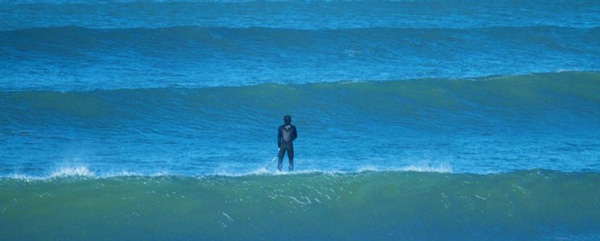
How It Begins

All of our weather across the Earth starts with the Sun’s initial energy input and its relentless nuclear fusion reaction. Through an uneven heating of the Earth’s surface we get large air circulation cells (Figure 1), in which air moves in accordance to temperature differences via Convection. We typically see warmer areas at the Equator and cool air at the Polar Regions. The temperature at the Poles can be a much as 70°C lower than that of the Equatorial regions during the winter; however in the summer this difference is a lot smaller. It is due to the 23.5 degree tilt of the Earth’s axis that we see this big swing in temperature difference, and it is this which gives us increased energy within the large air circulation cells through the winter months.
A Few Important Factors
As the air circulates around the globe we see warmer air rising from the Earth’s surface leaving a large ‘gap’ to be filled behind. As cooler air sinks back towards the Earth’s surface it tries to fill this large gap, rushing in across the Earth’s surface giving us the High and Low Pressure systems of our weather. For the formation of waves we are particularly interested in the large Low pressure systems and a force which affects their behaviour, The Coriolis Force. This is the result of the Earth’s rotation acting perpendicular to a body’s motion causing it to turn in an anti-cyclonic direction, or in simpler terms the result of wind movements relative to the Earth’s moving surface. We know that the air rushing in to fill the gap left by rising warmer air gives us a Low Pressure System, and it’s the Coriolis Force which determines in what direction the wind moves as it tries to fill the void.
Air Movements
Without any doubt it’s The Coriolis Force which has the most effect on the formation of waves for surfing. We know that the winds rushing in around a Low Pressure system in the Northern Hemisphere rotate (or are deflected) to the Right in an anti-clockwise direction, and clockwise around the rising air of a high pressure area. In the Southern Hemisphere this affect is mirrored, so now it’s clockwise for Lows, and anti-clockwise around Highs.
The Fully Developed Low Pressure System
Now we know the forces which are behind the large scale weather patterns we can begin to look towards our own interest in waves for surfing. The key instrument for us in producing these waves are the low pressure systems or mid latitude depressions (Figure 2), and with the added effect of The Coriolis Force, the swirling pattern of fast-moving surface air generates waves on the sea by frictional drag across the water surface, and we know that due to The Coriolis Force the air rushing in gets deflected at almost 90°, therefore running almost straight along the isobars we see on Pressure Charts.
The Formation of a Depression
At around 40 to 70° Latitude on the Earth’s surface, warm air moving up from South meets the dense cold air from the Artic Pole where we get the Polar Front; the general location of the wave producing Mid-latitude Depressions. As the less dense warm air tries to rise above the Cold Front we get a Baroclinic Instability as the warm and cold ‘Air Masses’ start to circulate around one another. If the conditions are right The Coriolis Force deflects the moving air into a vortex which then sucks in more energy forming a Low Pressure System.

The Warm Sector
The most important area for the production of waves within a Low is what’s known as The Warm Sector (Figure 3). This is an area behind the Warm Front within which the winds blow in a straight line for a prolonged period of time. As the Low grows in intensity the Cold Front tries to catch up to the Warm Front at which point the Low Pressure System loses its identity and begins to weaken. Before this moment however if the conditions are right the Low Pressure System can ‘stall’ holding position, pumping out waves for a few days as it grows in size and intensity, giving life to bigger and bigger surf.
Summary
By understanding our Large Scale Weather Patterns we are able to see where the winds responsible for producing waves come from. From the initial energy input from the Sun we get large Air Circulation Cells, and as a result from this moving air and the rotation of the Earth, The Coriolis Force is produced giving us the High and Low Pressure Systems responsible for our weather patterns on Earth.
With the understanding of The Coriolis Force, we are now able to see how this phenomena causes air to rotate in an anti-clockwise direction around Low Pressure areas in the northern hemisphere and clockwise around Lows in the southern hemisphere. By expanding on how the low pressure grows to become a fully developed system from its initial creation on the Polar Front, we are then able to spot the warm sector which gives us the best area for wave creation through winds blowing strong and straight over a prolonged period of time.
We now have the formation of waves through frictional drag upon the water’s surface from the wind, and next time we will look into how these waves grow and then begin to move across the oceans as free travelling swell in Part.2 – The growth and Propagation of Waves.
About the author – Scott Warren
Scott previously lived in South Devon where he attended Plymouth University and studied Surf Science and Technology. He became fascinated with why waves behave as they do, and how the environment in which we surf also plays its part.
Stand Up Paddle Boarding became Scotts way of life when he moved back to the Midlands to his family. Being away from the ocean and surf, SUP has given him more respect for the few moments a year when he gets the chance to visit the coast. As an instructor with Central SUP Paddle Boarding Scott has introduced a number of others into SUP surf for the first time. As part of his lessons Scott always tries to share some of his passion and experience with new and old paddlers alike, always in view of that next trip to the surf.
Though his fascination with waves Scott hopes to be able to give people a better understanding and respect for the environment which they enjoy, despite the cold, mixed up surf and long distances they have to travel living in the Midlands. And if others take one small thing and use it in their everyday surfing life then he considers his work a success.
Scott does not however pretend to be an expert in oceanography, SUP surf or the environmental impacts for that matter… just a paddler wishing to share some of his amazement for the oceans and waves. For more information and a deeper overall content of the surfing environment and its factors, Scott recomends ‘Surf Science – An Introduction to Waves for Surfing’
“I wish you all happy surfing. Remember to always have fun, enjoy and preserve the ocean environment. For the moments of pleasure it brings us would be lost without our respect and conservation” – Scott Warren
